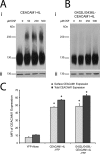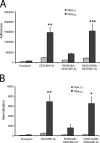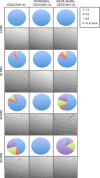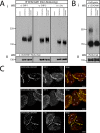Inside-out signaling promotes dynamic changes in the carcinoembryonic antigen-related cellular adhesion molecule 1 (CEACAM1) oligomeric state to control its cell adhesion properties
- PMID: 24005674
- PMCID: PMC3795263
- DOI: 10.1074/jbc.M113.504639
Inside-out signaling promotes dynamic changes in the carcinoembryonic antigen-related cellular adhesion molecule 1 (CEACAM1) oligomeric state to control its cell adhesion properties
Abstract
Cell-cell contacts are fundamental to multicellular organisms and are subject to exquisite levels of control. The carcinoembryonic antigen-related cell adhesion molecule 1 (CEACAM1) can engage in both cis-homophilic (parallel) oligomerization and trans-homophilic (anti-parallel) binding. In this study, we establish that the CEACAM1 transmembrane domain has a propensity to form cis-dimers via the transmembrane-embedded (432)GXXXG(436) motif and that this basal state is overcome when activated calmodulin binds to the CEACAM1 cytoplasmic domain. Although mutation of the (432)GXXXG(436) motif reduced CEACAM1 oligomerization, it did not affect surface localization of the receptor or influence CEACAM1-dependent cellular invasion by the pathogenic Neisseria. The mutation did, however, have a striking effect on CEACAM1-dependent cellular aggregation, increasing both the kinetics of cell-cell association and the size of cellular aggregates formed. CEACAM1 association with tyrosine kinase c-Src and tyrosine phosphatases SHP-1 and SHP-2 was not affected by the (432)GXXXG(436) mutation, consistent with their association with the monomeric form of wild type CEACAM1. Collectively, our results establish that a dynamic oligomer-to-monomer shift in surface-expressed CEACAM1 facilitates trans-homophilic binding and downstream effector signaling.
Keywords: Bacterial Adhesion; CEACAM1; Calcium Signaling; Calmodulin; Cancer; Carcinoembryonic Antigen-related Cell Adhesion Molecule; Cell Adhesion; Homodimer; Homophilic Binding; Membrane Proteins.
Figures










Similar articles
-
Homophilic adhesion and CEACAM1-S regulate dimerization of CEACAM1-L and recruitment of SHP-2 and c-Src.J Cell Biol. 2009 Nov 16;187(4):569-81. doi: 10.1083/jcb.200904150. J Cell Biol. 2009. PMID: 19948503 Free PMC article.
-
Carcinoembryonic antigen-related cell adhesion molecule 1 inhibits proximal TCR signaling by targeting ZAP-70.J Immunol. 2008 May 1;180(9):6085-93. doi: 10.4049/jimmunol.180.9.6085. J Immunol. 2008. PMID: 18424730 Free PMC article.
-
The transmembrane domain of CEACAM1-4S is a determinant of anchorage independent growth and tumorigenicity.PLoS One. 2012;7(1):e29606. doi: 10.1371/journal.pone.0029606. Epub 2012 Jan 3. PLoS One. 2012. PMID: 22235309 Free PMC article.
-
Structural aspects of CEACAM1 interactions.Eur J Clin Invest. 2024 Dec;54 Suppl 2:e14357. doi: 10.1111/eci.14357. Epub 2024 Nov 18. Eur J Clin Invest. 2024. PMID: 39555955 Review.
-
Mechanism and function of CEACAM1 splice isoforms.Eur J Clin Invest. 2024 Dec;54 Suppl 2(Suppl 2):e14350. doi: 10.1111/eci.14350. Eur J Clin Invest. 2024. PMID: 39674874 Free PMC article. Review.
Cited by
-
CEACAM1 promotes CD8+ T cell responses and improves control of a chronic viral infection.Nat Commun. 2018 Jul 2;9(1):2561. doi: 10.1038/s41467-018-04832-2. Nat Commun. 2018. PMID: 29967450 Free PMC article.
-
Diverse oligomeric states of CEACAM IgV domains.Proc Natl Acad Sci U S A. 2015 Nov 3;112(44):13561-6. doi: 10.1073/pnas.1509511112. Epub 2015 Oct 19. Proc Natl Acad Sci U S A. 2015. PMID: 26483485 Free PMC article.
-
Structural characterization of a dimeric complex between the short cytoplasmic domain of CEACAM1 and the pseudo tetramer of S100A10-Annexin A2 using NMR and molecular dynamics.Biochim Biophys Acta Biomembr. 2021 Jan 1;1863(1):183451. doi: 10.1016/j.bbamem.2020.183451. Epub 2020 Aug 21. Biochim Biophys Acta Biomembr. 2021. PMID: 32835655 Free PMC article.
-
Glycosylation Alters Dimerization Properties of a Cell-surface Signaling Protein, Carcinoembryonic Antigen-related Cell Adhesion Molecule 1 (CEACAM1).J Biol Chem. 2016 Sep 16;291(38):20085-95. doi: 10.1074/jbc.M116.740050. Epub 2016 Jul 28. J Biol Chem. 2016. PMID: 27471271 Free PMC article.
-
CEACAM1 structure and function in immunity and its therapeutic implications.Semin Immunol. 2019 Apr;42:101296. doi: 10.1016/j.smim.2019.101296. Semin Immunol. 2019. PMID: 31604530 Free PMC article. Review.
References
-
- Okegawa T., Pong R. C., Li Y., Hsieh J. T. (2004) The role of cell adhesion molecule in cancer progression and its application in cancer therapy. Acta Biochim. Pol. 51, 445–457 - PubMed
-
- Beauchemin N., Draber P., Dveksler G., Gold P., Gray-Owen S., Grunert F., Hammarström S., Holmes K. V., Karlsson A., Kuroki M., Lin S. H., Lucka L., Najjar S. M., Neumaier M., Obrink B., Shively J. E., Skubitz K. M., Stanners C. P., Thomas P., Thompson J. A., Virji M., von Kleist S., Wagener C., Watt S., Zimmermann W. (1999) Redefined nomenclature for members of the carcinoembryonic antigen family. Exp. Cell Res. 252, 243–249 - PubMed
-
- Hinoda Y., Neumaier M., Hefta S. A., Drzeniek Z., Wagener C., Shively L., Hefta L. J., Shively J. E., Paxton R. J. (1988) Molecular cloning of a cDNA coding biliary glycoprotein I: primary structure of a glycoprotein immunologically cross-reactive with carcinoembryonic antigen. Proc. Natl. Acad. Sci. U.S.A. 85, 6959–6963 - PMC - PubMed
Publication types
MeSH terms
Substances
Grants and funding
LinkOut - more resources
Full Text Sources
Other Literature Sources
Miscellaneous

